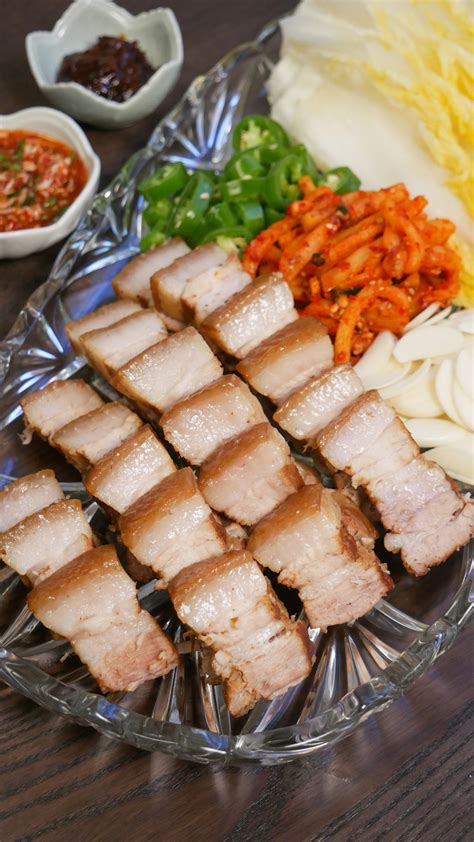Korean Belly Pork Recipes: A Delicious Culinary Journey
Korean food is renowned globally for its bold flavors and unique culinary techniques. At the heart of many beloved Korean dishes lies the humble but incredibly versatile pork belly – samgyeopsal. This guide will explore several delectable Korean belly pork recipes, perfect for both seasoned cooks and culinary novices.
Understanding the Magic of Samgyeopsal
Before diving into specific recipes, let's appreciate the star ingredient: Korean pork belly. Unlike other cuts, samgyeopsal boasts a delightful balance of tender meat and luscious fat, delivering a rich and satisfying experience. The fat renders beautifully during cooking, creating a crispy, flavorful exterior while keeping the meat incredibly juicy inside. This inherent richness makes it the perfect canvas for the complex flavor profiles characteristic of Korean cuisine.
Key Ingredients and Techniques
Many Korean pork belly recipes rely on a foundation of:
- Gochujang: A fermented chili paste, providing a sweet, savory, and spicy base.
- Gochugaru: Korean chili flakes, adding heat and vibrant color.
- Soy Sauce: For savory depth and umami.
- Garlic & Ginger: Essential aromatics that elevate the entire dish.
- Sesame Oil: Adds a nutty, fragrant finish.
- Green Onions: A fresh, herbaceous counterpoint to the richness of the pork.
Mastering the technique of perfectly rendering the fat is crucial. This can be achieved through various methods: pan-frying, roasting, or grilling. The goal is a crispy exterior and tender interior—a textural contrast that defines a truly great Korean pork belly dish.
Simple & Delicious Korean Belly Pork Recipes
Here are a few mouthwatering recipes to get you started:
1. Pan-fried Samgyeopsal with Gochujang Glaze
This recipe is perfect for a quick weeknight meal. Thinly sliced pork belly is pan-fried until crispy, then coated in a sweet and spicy gochujang glaze. Serve with steamed rice and kimchi for a complete Korean experience.
Ingredients:
- 1 lb pork belly, thinly sliced
- 2 tbsp gochujang
- 1 tbsp soy sauce
- 1 tbsp honey or brown sugar
- 1 tsp sesame oil
- 1 clove garlic, minced
- 1 tsp gochugaru (adjust to taste)
- Sesame seeds for garnish
Instructions:
- Whisk together the gochujang, soy sauce, honey/sugar, sesame oil, garlic, and gochugaru.
- Pan-fry the pork belly until crispy and golden brown on both sides.
- Brush the cooked pork belly with the gochujang glaze and cook for another minute.
- Garnish with sesame seeds and serve immediately.
2. Roasted Korean Belly Pork with Kimchi and Vegetables
For a more substantial meal, try this roasted version. The pork is roasted alongside kimchi and vegetables, infusing the entire dish with a vibrant array of flavors.
Ingredients:
- 1 lb pork belly, cut into 1-inch cubes
- 1 cup kimchi, chopped
- 1/2 cup vegetables (e.g., onions, potatoes, carrots), chopped
- 2 tbsp soy sauce
- 1 tbsp gochujang
- 1 tbsp honey
- 1 tsp sesame oil
- Garlic and ginger, minced
Instructions:
- Marinate the pork belly in a mixture of soy sauce, gochujang, honey, sesame oil, garlic, and ginger for at least 30 minutes.
- Toss the marinated pork belly with the kimchi and vegetables.
- Roast in a preheated oven at 375°F (190°C) for approximately 45-60 minutes, or until the pork is tender and crispy.
3. Grilled Korean Belly Pork with Scallions and Ssamjang
For a truly authentic experience, grill your samgyeopsal! The char adds another layer of deliciousness. Serve with fresh scallions, ssamjang (a spicy fermented soybean paste), and lettuce wraps.
Ingredients:
- 1 lb pork belly, thinly sliced
- Scallions, chopped
- Ssamjang (store-bought or homemade)
- Lettuce leaves for wrapping
Instructions:
- Grill the pork belly over medium heat until cooked through and slightly charred.
- Serve immediately with chopped scallions, ssamjang, and lettuce leaves for wrapping.
Exploring Beyond the Basics
These are just starting points. Feel free to experiment with different marinades, vegetables, and side dishes to create your own unique Korean belly pork masterpiece. Don't be afraid to adjust the level of spiciness to your preference, and most importantly, enjoy the culinary journey!
